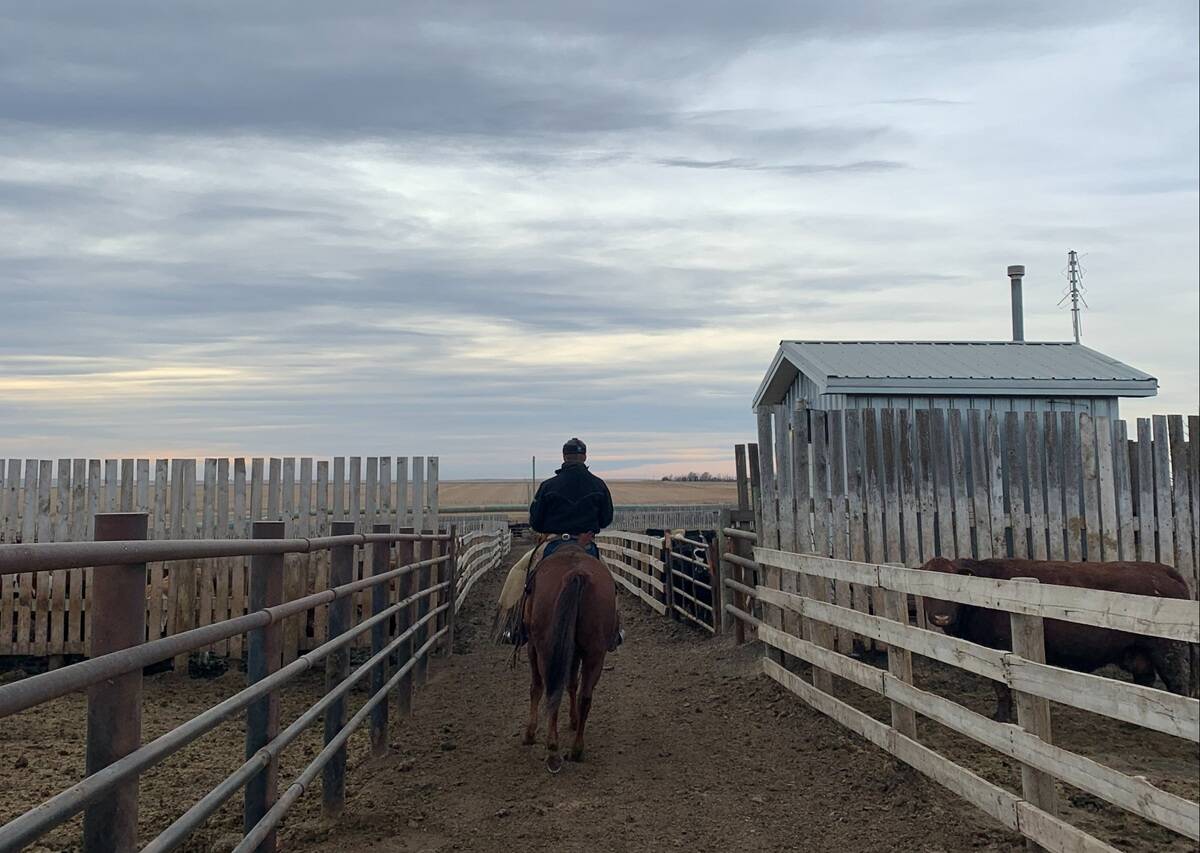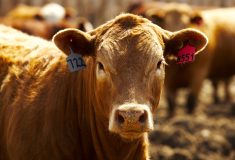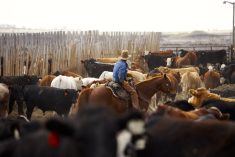Fed cattle
Fed cattle prices are trading mostly sideways. As of mid-October, the fed steer cash average in Alberta had ranged from $156/ cwt to $158/cwt over the past seven weeks. The mid-October average is $156.81/cwt. Basis is still at a premium, with the spot basis at +$2.90/cwt, compared to a five-year average of -$1.84/cwt. Cut-out value has been moving lower seasonally, but seems to be near the bottom.
Fed steer slaughter in Canada is up nine per cent, as of October 9, compared to a year ago. Steer slaughter totals 1,411,358 head while heifer slaughter is up 11 per cent at 761,457 head. Carcass weights are still large, creating more product to move through the system. The first two weeks of October saw a 12-pound increase in steer carcass weight. The October 9 steer carcass weight average was 948 lbs., six pounds larger than the same week last year.
Read Also

Pen riders still better than tech at detecting respiratory disease in feedlot cattle, says researcher
Recent research found that pen riders are better than tech at flagging signs of BRD in feedlot cattle
Boxed beef exports remain strong. August trade numbers showed a 29 per cent export increase, with year-to-date data showing exports up 25 per cent from a year ago. For the first nine months of 2021, imported boxed beef was down 20 per cent, putting Canada into a positive trade balance. Live cattle trade is still below a year ago. Fed cattle exports, including cows, are down 12 per cent from a year ago, totalling 320,495 head as of October 2.
The October 15 Alberta and Saskatchewan cattle-on-feed report shows on-feed inventories were 17 per cent above a year ago, totalling 929,453 head. Feedlot placements were smaller than a year ago, reflecting large numbers of feeders placed through July and August. Through September, feeder placements were down six per cent at 203,705 head. Steer placements through September were larger in 2021 while heifer placements were back 24 per cent from September 2020.
Deb’s outlook for fed cattle: Fed cattle front-end supplies are manageable but in the near term, packers have secured inventory for the next few weeks and large carcass weights are burdensome. However, the last two months of the year should see supplies tighten, demand sharpen and prices rally. Heading towards the U.S. Thanksgiving holiday right through the New Year, strong beef demand should support fed prices. In addition, the export market is expected to remain strong, supporting the fed cash market.
Feeder cattle
The fall run started early, with auction market volumes from July 1 to mid-October 56 per cent higher than a year ago.
That being said, auction volumes have also been large recently as producers who didn’t have to sell early are now weaning calves. The additional volume, coupled with feedlots still looking to market remaining summer-fed cattle to free pen space, has led to a declining calf market.
The 550-lb. feeder steers in mid-October averaged $215.92/cwt, $9.19/ cwt below the September peak but still more than $4/cwt higher than a year ago. Heifer calves in the same weight class are $34.38/cwt back from the steers, averaging $181.54/cwt. Most yearlings across the Prairies were sold early due to deteriorating pastures; however, the market has held steady. Light volumes of 850-lb. feeder steers averaged $191.35/cwt in mid-October, down $4.53/cwt from the September high but $2.27/cwt higher than last year.
The 850-lb. feeder basis is wide, at -$4.60/cwt in mid-October. The five-year average is nearly $10/cwt stronger at +$4.85/cwt. Feeder calf exports through the fall run have outpaced a year ago, with feeder exports up two per cent to 91,531 head as of October 2.
Deb’s outlook for feeder cattle: Several factors affect the feeder market and most of those factors seem to be in play in 2021. Record-high feed costs should drive the feeder market lower. However, imported corn seems to be relieving some pressure. A higher Canadian dollar generally is a negative factor and will have some play on the feeder market, but it also gives feedlots more corn-buying power for feeders staying in Canada. In the past month, the futures market and export market potential have created optimism among feeder buyers for the 2022 market, supporting the feeder market. Expect seasonal pressure in the feeder market in the near term as larger volumes move through the system. As volumes start to slow later into the fourth quarter, prices will stabilize and could rally if the 2022 optimism continues.
Non-fed cattle
The number of cows on offer through October hit the non-fed market hard. Prices are at their lowest this year. The mid-October D1,2 cow average in Western Canada is $75.80/cwt, down $7.13/ cwt from the same week a year ago and $10.18/cwt below the five-year average.
Weekly cow slaughter rates have been high, adding to the year-to-date total of 340,062 head, up 11 per cent from a year ago. Bull slaughter in Canada is up 51 per cent to 13,789 head as of October 9.
Butcher bull exports are down 11 per cent this year, totalling 28,964 head at September’s end. The additional non-fed cattle available pressured cull bull prices lower. The mid-October bull average is $101.63, down nearly $5.00/cwt since both the start of October and the same week in 2020.
Deb’s outlook for non-fed cattle: Cull cattle prices tend to see their annual low before November which should be the case this year. As volumes slow and year-end beef demand picks up, the non-fed market should also improve. In the immediate near term, expect more pressure in the market as the bulk of the fall-marketed cows head to town and the last heavy fed cattle move through the system. Looking towards the end of 2021, prices should improve in response to better beef movement, lighter volumes and continued positive trade balance.
















